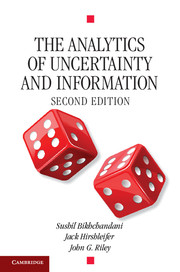1 - Elements of Decision under Uncertainty
Published online by Cambridge University Press: 05 August 2013
Summary
We introduce a model for decision making under uncertainty that will be our workhorse throughout the book. Uncertainty is modeled with a set of states of nature, one of which will occur. The decision maker or individual has a probability distribution over the states of nature that represents his (or her) subjective beliefs about the likelihood of different states of nature. This individual chooses actions and actions have consequences. The consequence for the individual depends on the state of nature and his choice of action. The states of nature are represented in a way that the probabilities of states are unaffected by the individual's actions. The individual's preferences over consequences are captured by a utility function. The probability distribution over states of nature and the utility function over consequences, both of which are subjective, are combined by the expected-utility rule to induce an expected utility over actions.
An individual must choose among acts – or synonymously, he or she must make decisions, or select among actions, options, or moves. And, where there is uncertainty, nature may be said to “choose” the state of the world (or state, for short). You decide whether or not to carry an umbrella; nature “decides” on rain or sunshine. Table 1.1 pictures an especially simple 2 × 2 situation. Your alternative acts x = (1, 2) are shown along the left margin, and nature's alternative states s = (1, 2) across the top. The body of the table shows the consequences cxs resulting from your choice of act x and nature's choice of state s.
- Type
- Chapter
- Information
- The Analytics of Uncertainty and Information , pp. 7 - 45Publisher: Cambridge University PressPrint publication year: 2013

